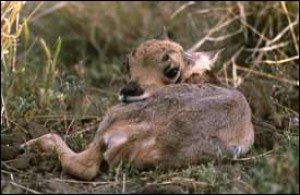Coyote hunt kills 669 over two years
arizonadailysun.com
Its strange red and white face, graceful form and incredible speed are alien on our continent. The American pronghorn antelope looks like it belongs on an African savanna because it evolved in a similar, but entirely independent way — outrunning the now-extinct American cheetah.
Known as the prairie ghost, the modern pronghorn now faces off against another nemesis: the coyote. The wily predator doesn't stand a chance at running down the fastest creature in North America, but instead decimates their numbers by preying on fawns, which lie hidden and motionless after birth.
"There are a lot of things that have happened historically — fire suppression, juniper encroachment, erosion, drought, climate alteration — all of those things are working against ungulates in the state," said Brian Wakeling, big game program supervisor for the Arizona Department of Game and Fish.
And in the forests and high deserts of northern Arizona, he says changing vegetation has limited what there is to eat while giving coyotes the jump on pronghorn.
MORE INCLINED TO REPRODUCE
But over the past several years, the state of Arizona has been testing the economic viability of large-scale coyote killing to help the pronghorn.
Flying low and slowly in airplanes across the high desert, wildlife managers have been systematically removing coyotes from Game Management Unit 10, which occupies a large chunk of land stretching south of Grand Canyon to Williams and west of Highway 64.
Between 2010 and 2012, the Arizona Department of Game and Fish paid $120,000 to shoot 669 coyotes — mostly from an airplane. Most of that was paid to the U.S. Department of Agriculture for the shooting program.
This sort of coyote eradication is rarely attempted in modern times.
Most wildlife managers believe it's too pricey. And conservationists argue that it's ineffective because the coyotes breed faster as a result and bounce back without continued aerial gunning.
"By killing some of the (coyotes), especially the larger males, it results in an increase in population as they become more inclined to reproduce," said Kim Crumbo, conservation director for the Grand Canyon Wildlands Council.
"It doesn't really reduce the population long-term, so the whole thing is questionable," he said.
LIMITED DIRECT ECONOMIC BENEFIT
Wakeling spearheaded the coyote project near the Grand Canyon and says his goal was to see if there was enough economic benefit from killing coyotes to offset the high cost. He hoped that the increased sales of pronghorn hunting permits might bring in enough revenue to pay for sustained aerial gunning.
And killing nearly 700 coyotes had a considerable impact on the area. The pronghorn population multiplied four times in just two years. Meanwhile, in an untreated area nearby, there was no change in population.
But in the end, the economic benefit to Game and Fish has been minimal so far. The massive increase in population brought in just $10,425 more revenue from permits, according to a study published by Wakeling. The final results have yet to be seen.
However, Wakeling says the desire to preserve the pronghorn meant that there has not been a large increase in the number of hunting permits sold, despite the massive increase in animals.
But he did examine the local economic impact of bringing more hunters to northern Arizona. Hunters are known to shovel large amounts of revenue to places like Flagstaff through gas purchases, hotel stays, restaurant meals and outdoor supplies.
Wakeling estimates that an extra $88,000 was pumped into the local economy by hunters that wouldn't otherwise have been realized.
However, he cautioned that the model would not work everywhere. It succeeded in Unit 10 because there is enough forage material to support a larger pronghorn population. The animal's numbers have been limited by coyotes.
Wakeling said that Game and Fish is still considering what to do with the new information, but its decision is not simply one of economics. As the state's wildlife managers, they also care for populations with limited to no economic return, such as the Chiricahua leopard frog and bighorn sheep. Pronghorn is another animal that's hunted very conservatively.
WOLVES JUST AS EFFECTIVE?
Crumbo, who has been critical of Game and Fish in the past, called the results "compelling" because pronghorn populations are in trouble. He also said that outdoor recreation, wildlife viewing and hunting have a large economic impact, so bumping up pronghorn could be a positive for the area.
But he criticized the idea of haphazardly removing coyotes from an ecosystem, saying it would most certainly affect other creatures in unforeseen ways throughout the food chain.
He suggested a better way to keep coyote populations in check could be to restore predators to the area such as the Mexican gray wolf. The wolf is another age-old enemy of the coyote. In areas like Yellowstone and the Tetons, where wolves have been restored, coyote populations have dropped and antelope are on the rise, according to Crumbo. The wolf also doesn't seem to bother looking for fawns and has had a symbiotic relationship with antelope elsewhere, he said.
But Wakeling questions how successful wolves could be in surviving in an area without elk or large deer and says it's unlikely the wolf population could become substantial enough to impact coyotes.
Crumbo pointed out that Game and Fish officials questioned how successful the small wolf would be hunting big game like elk. The 15-year recovery program has shown the animals to be highly successful.
"Until we get our full suite of large carnivores back, it's always going to be a balancing act of trying to favor one animal over another," Crumbo said.











No comments:
Post a Comment